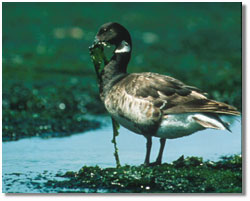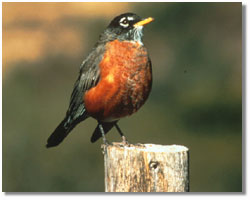| |

Branta bernicla, a.k.a. the Brant
Credit: Craig Larcom, Cornell Lab of Ornithology |
| |
| |

Turdus migratorius, a.k.a. the American robin
For larger photos, media should contact Marge Villanova, Cornell Lab of Ornithology, 607-254-2473.
Credit: Art Biale, Cornell Lab of Ornithology |
| |
| |
 Note About Images Note About Images |
ARLINGTON, Va.—Wanted: Branta bernicla, a.k.a. the Brant, for poorly understood movements across North America from northern Canada and Alaska to Mexico.
The Brant—a small, dark goose vulnerable to declines in its various coastal populations—tops this year's Spring Migration Top 10 "Most Wanted" list, recently posted by eBird. This high-tech web portal lets birders everywhere track their sightings while contributing to the big-picture understanding of North American bird populations.
"Through eBird we are assembling a fine-scaled biological data set with broad geographic coverage—one of only a few available for addressing biogeographic questions that we've been unable to answer previously," said John Fitzpatrick, director of the Cornell Lab of Ornithology. eBird, a project of the Cornell Lab and the Audubon Society, is supported by a $2.25 million award from the National Science Foundation (NSF).
Not all the birds on the Top 10 list are showing population declines. Some, like the Mississippi kite and the sandhill crane, appear to be increasing in number and expanding their territory. Even the common American robin makes the list because its migration and breeding patterns aren’t well understood.
The species on eBird's four annual "Most Wanted" lists span geographic regions and include "hot" birds of interest to avid bird chasers and more common birds seen by backyard birders. And behind each selection are unanswered scientific questions.
To answer such questions, field observations are essential, and that's where eBird comes in. Observations from each of the nearly 7,000 registered eBirders are pooled in a vast database, which currently contains more than 15 million bird sightings. The observations provide distribution data, peak counts, nesting locales, migration timing, discovery of small populations and documentation of range expansion or contraction.
As eBird amasses more and more information across the continent, researchers will be able to track bird species' movements within a season and among seasons. They will look for patterns in nomadic movements, post-breeding wandering, colonization of new areas, migratory routes and more.
"Along with the immense amount of data we expect to continue archiving from observers, we are excited by the prospect of receiving historical data," Fitzpatrick said. "Thousands of birders from across the continent have decades of bird observation data that have never been accessible to researchers. Through eBird, these untapped resources will help us understand changes in abundance and distribution of birds."
For birders ranging from beginners to experts, the Cornell Lab has also recently established the "All About Birds" web site with support from NSF. "All About Birds" provides birding how-tos, a bird guide with photographs and maps, information on conservation programs and tips for collecting and understanding bird data.
"The Cornell Lab of Ornithology has been a pioneer in 'citizen science'—engaging members of the public in activities that are meaningful to them and also meaningful to science," said NSF program officer David Ucko. "Along with the new 'All About Birds' site, this project does a tremendous job integrating research, education and conservation."
|
|
The National Science Foundation (NSF) is an independent federal agency that supports fundamental research and education across all fields of science and engineering, with an annual budget of nearly $5.58 billion. NSF funds reach all 50 states through grants to nearly 2,000 universities and institutions. Each year, NSF receives about 40,000 competitive requests for funding, and makes about 11,000 new funding awards. The NSF also awards over $200 million in professional and service contracts yearly.
Receive official NSF news electronically through the e-mail delivery and notification system, Custom News Service. To subscribe, enter the NSF Home Page at: http://www.nsf.gov/home/cns/#new and fill in the information under "new users."
Useful NSF Web Sites:
NSF Home Page: http://www.nsf.gov
News Highlights: http://www.nsf.gov/od/lpa
Newsroom: http://www.nsf.gov/od/lpa/news/media/start.htm
Science Statistics: http://www.nsf.gov/sbe/srs/stats.htm
Awards Searches: http://www.fastlane.nsf.gov/a6/A6Start.htm
|

